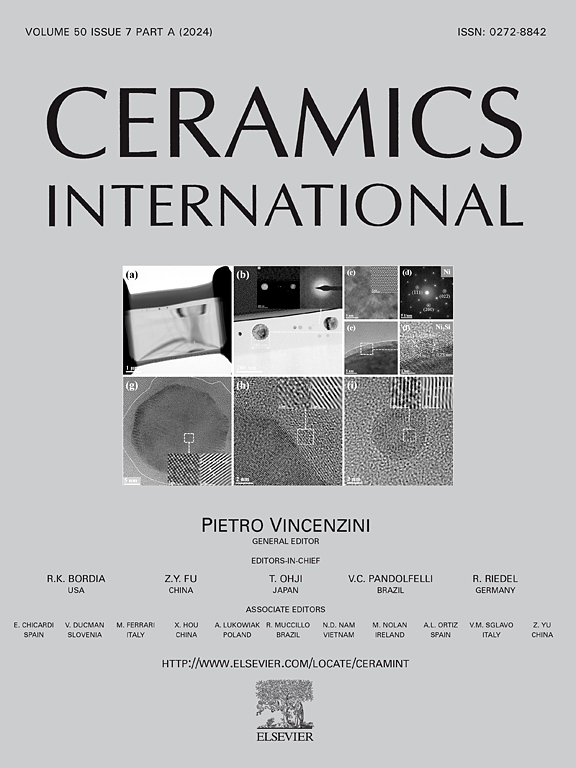Photovoltaic Properties of Bismuth Vanadate/Bismuth Ferrite Heterostructures Prepared by Spin Coating
IF 5.1
2区 材料科学
Q1 MATERIALS SCIENCE, CERAMICS
引用次数: 0
Abstract
This study investigates the photovoltaic performance of bismuth vanadate (BiVO₄)/bismuth ferrite (BiFeO₃) heterostructures. By varying the pre-annealing temperature of the BiVO₄ layer, we have achieved the significant enhancement in the open-circuit voltage (Voc) with the spontaneous formation of the polarized Bi4V2O11 interfacial layer. X-ray diffraction analysis confirms a pure rhombohedral distorted perovskite structure for BiFeO₃ and a monoclinic crystallographic nature for BiVO₄. SEM analysis exhibits a porous structure with small spherical grains in the BiVO₄ layer, with the dense and smooth surface of the BiFeO₃ layer. The heterostructures observed in a red-shifted absorption edge are compared with the individual materials, which indicates an improved light absorption. Tauc plot analysis has yielded the direct bandgap values of 1.88 eV and 1.83 eV for the BiVO4 annealing temperatures at 150 and 500 °C, respectively. The overall power conversion efficiency (η) has remained low at 0.003 % and 0.005 %, demonstrating the potential of interfacial engineering to optimize the photovoltaic properties of BiVO₄/BiFeO₃ heterostructures.
求助全文
约1分钟内获得全文
求助全文
来源期刊

Ceramics International
工程技术-材料科学:硅酸盐
CiteScore
9.40
自引率
15.40%
发文量
4558
审稿时长
25 days
期刊介绍:
Ceramics International covers the science of advanced ceramic materials. The journal encourages contributions that demonstrate how an understanding of the basic chemical and physical phenomena may direct materials design and stimulate ideas for new or improved processing techniques, in order to obtain materials with desired structural features and properties.
Ceramics International covers oxide and non-oxide ceramics, functional glasses, glass ceramics, amorphous inorganic non-metallic materials (and their combinations with metal and organic materials), in the form of particulates, dense or porous bodies, thin/thick films and laminated, graded and composite structures. Process related topics such as ceramic-ceramic joints or joining ceramics with dissimilar materials, as well as surface finishing and conditioning are also covered. Besides traditional processing techniques, manufacturing routes of interest include innovative procedures benefiting from externally applied stresses, electromagnetic fields and energetic beams, as well as top-down and self-assembly nanotechnology approaches. In addition, the journal welcomes submissions on bio-inspired and bio-enabled materials designs, experimentally validated multi scale modelling and simulation for materials design, and the use of the most advanced chemical and physical characterization techniques of structure, properties and behaviour.
Technologically relevant low-dimensional systems are a particular focus of Ceramics International. These include 0, 1 and 2-D nanomaterials (also covering CNTs, graphene and related materials, and diamond-like carbons), their nanocomposites, as well as nano-hybrids and hierarchical multifunctional nanostructures that might integrate molecular, biological and electronic components.
 求助内容:
求助内容: 应助结果提醒方式:
应助结果提醒方式:


